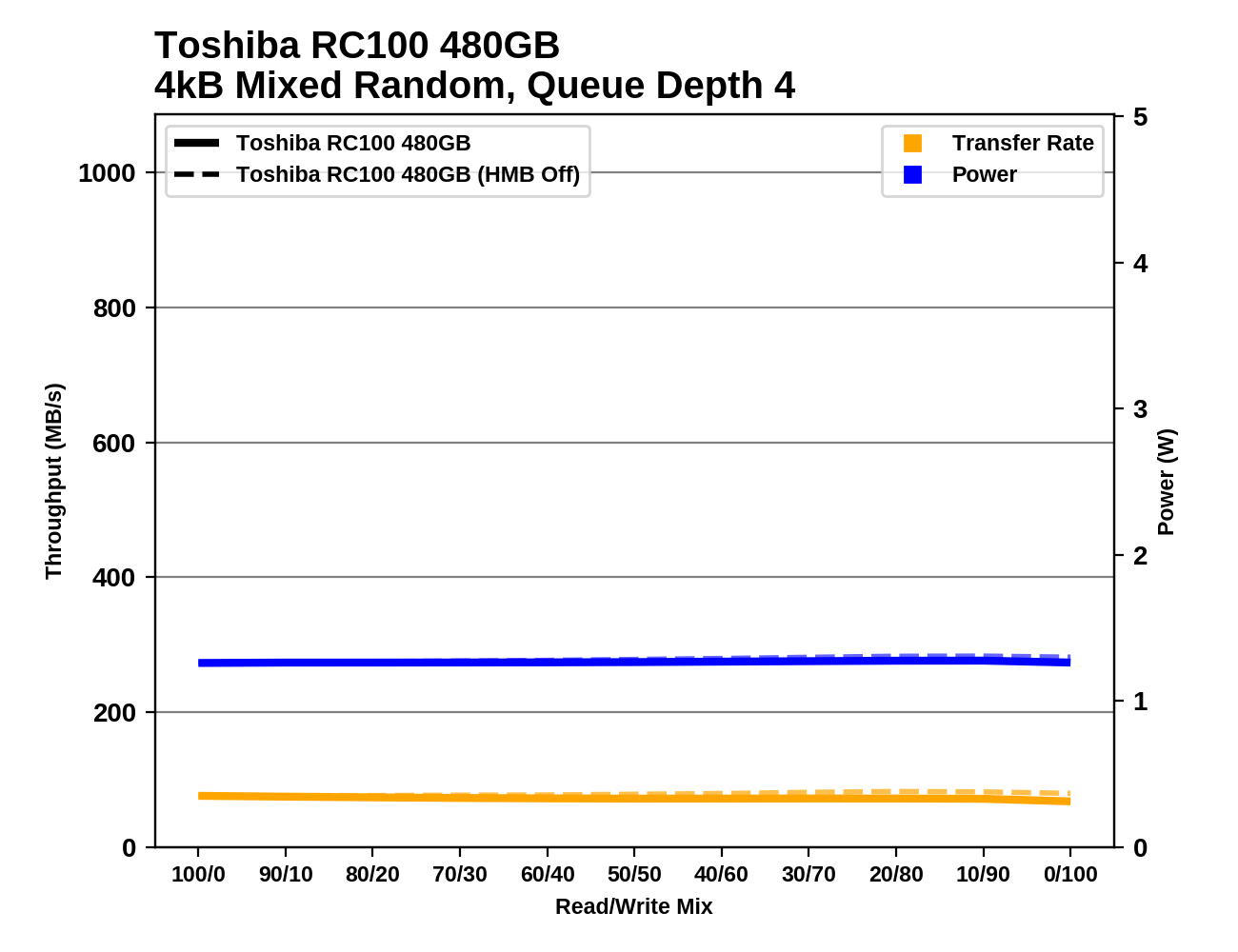The Toshiba RC100 SSD Review: Tiny Drive In A Big Market
by Billy Tallis on June 14, 2018 9:00 AM ESTMixed Random Performance
Our test of mixed random reads and writes covers mixes varying from pure reads to pure writes at 10% increments. Each mix is tested for up to 1 minute or 32GB of data transferred. The test is conducted with a queue depth of 4, and is limited to a 64GB span of the drive. In between each mix, the drive is given idle time of up to one minute so that the overall duty cycle is 50%.

Mixed workloads are often the toughest for DRAMless SSDs, and with this mixed random I/O test covering 64GB of the drive, the Toshiba RC100's Host Memory Buffer is of little use. The RC100 is substantially slower than other NVMe drives on this test.
 |
|||||||||
| Power Efficiency in MB/s/W | Average Power in W | ||||||||
Power efficiency from the RC100 during the mixed random I/O test is also poor, but it's not a significant outlier compared from the competition. Total power consumption is half a Watt lower than any of the other NVMe drives.
 |
|||||||||
The performance and power consumption of the Toshiba RC100 are remarkably constant across the varying workload of this test. There's no sign of improved performance as the fraction of writes increases, which gives most SSDs the opportunity to perform more write combining.
Mixed Sequential Performance
Our test of mixed sequential reads and writes differs from the mixed random I/O test by performing 128kB sequential accesses rather than 4kB accesses at random locations, and the sequential test is conducted at queue depth 1. The range of mixes tested is the same, and the timing and limits on data transfers are also the same as above.

On the mixed sequential I/O test, the Toshiba RC100 is a decent performer with an average that exceeds what any SATA SSD is capable of. HMB is a bit of help here because the sequential access pattern is very cache-friendly even though the test spans a wider range of data than the cache can track.
 |
|||||||||
| Power Efficiency in MB/s/W | Average Power in W | ||||||||
The Toshiba RC100's power efficiency on the mixed sequential I/O test is great with or without HMB. The RC100 is clearly much slower than the high-end drives, but its power consumption is reduced proportionally.
 |
|||||||||
The performance and power consumption of the Toshiba RC100 are not quite as flat on the mixed sequential test as for the mixed random I/O test. The RC100 gets a bit faster as the workload shifts toward writes, and HMB becomes more beneficial with increasing write volume.










62 Comments
View All Comments
PeachNCream - Thursday, June 14, 2018 - link
I care. I like seeing what's happening in the rest of the market outside of the highest end hardware since I am more likely to allocate less money to a computer than is required to get top performing parts. Why waste the money on something as unimportant as a computer component when there's a retirement account and a comfortable post-work life to enjoy as soon as humanly possible? Priorities kid, you've got to figure out what matters most in life. Protip: It's not computer parts.chrnochime - Thursday, June 14, 2018 - link
You!= everyone. So don't ask such silly question as "did anyone care" because of course there are ppl out there that care.smilingcrow - Thursday, June 14, 2018 - link
970 Pro is mainly for show-offs. If you actually need high end performance there are faster and more cost effective solutions.mr_tawan - Friday, June 15, 2018 - link
It's probably down the pipe. And if it's not, then you can buy them a review unit.bananaforscale - Monday, July 9, 2018 - link
Like it or not, low end sells much more than high. Not that a low-end NVMe drive is slow by typical standards.u.of.ipod - Thursday, June 14, 2018 - link
Billy nice write-up, good to see something a little different. I've read some reviews and am wondering why NVMe is really taking off for lower end drives? From what I can tell even if you compare top of the line NVMe drives against your average SATA SSD, the real world differences are pretty slim for the majority of use cases. Why try to shove NVMe into the low-end market? Is SATA going away? Are many new M.2 slots not compatible with both SATA and NVMe?I've really only used SATA M.2 drives thus far and have been happy with the results.
MajGenRelativity - Thursday, June 14, 2018 - link
I'm not sure why, but it could be about standardizing on NVMe. If everything supports NVMe, there don't need to be as many SATA ports, which saves companies some moneyMidwayman - Thursday, June 14, 2018 - link
Halo effect and marketing? Is there really any reason a NVMe drive needs to be more expensive? So long as most computers are supporting it now you might as well standardize new drives on the newer interface.bug77 - Thursday, June 14, 2018 - link
On top of that, NVMe comes with higher power draw. Because PCIe vs SATA.PeachNCream - Thursday, June 14, 2018 - link
That can be fixed with technological development. For now, SATA is more power-efficient, but as NVMe becomes more popular, market forces will create a demand for higher efficiencies and the problem will be soon enough.